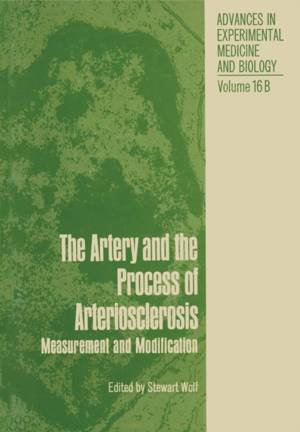
- Afhalen na 1 uur in een winkel met voorraad
- Gratis thuislevering in België vanaf € 30
- Ruim aanbod met 7 miljoen producten
- Afhalen na 1 uur in een winkel met voorraad
- Gratis thuislevering in België vanaf € 30
- Ruim aanbod met 7 miljoen producten
Zoeken
The Artery and the Process of Arteriosclerosis
Measurement and Modification, the Second Half of the Proceedings of an Interdisciplinary Conference on Fundamental Data on Reactions of Vascular Tissue in Man, April 19-25, 1970, Lindau, West Germany
Stewart Wolf
€ 153,95
+ 307 punten
Omschrijving
Substantial progress toward reconciling disparate theories of the pathogenesis of arteriosclerosis was recorded in Volume I of this book. the proceedings of an interdisciplinary workshop conference held at Lindau. Germany, April 19-25, 1970. Strong evidence was ad- duced that the early stages of arteriosclerosis consist of intimal proliferation similar to that associated with the increase in arteri- al size and caliber that characterizes normal growth. The findings described recall a theory proposed by Richard Thoma (Thoma and Kaefer, 1889) of Heidelberg toward the end of the nineteenth century. He sug- gested that the pathogenesis of arteriosclerosis began with intimal thickening that was initially adaptive. Past a certain point, how- ever, the thickening compromised the nutrition of the artery wall, leading inevitably to degenerative changes. In 1944 Hueper (Hueper, 1944), reemphasized the threat to the nu- tritional support of the artery and proposed that the many etiologic factors capable of inducing arterial atheroma did so through the final common pathway of interfering with oxidative mechanisms in the vessel wall. Thus, it is proposed that arteriosclerosis is basically an aspect of the "behavior" of the artery. The nature of the lesion, therefore, depends more on the biochemical and structural response capabilities of the tissue itself than on the characteristics of the various etiologic agents. The idea that arteriosclerosis begins as uncontrolled or disturbed adaptive behavior was shared by Duff and also by Winternitz (Duff, 1954; Winternitz, 1954).
Specificaties
Betrokkenen
- Auteur(s):
- Uitgeverij:
Inhoud
- Aantal bladzijden:
- 337
- Taal:
- Engels
- Reeks:
- Reeksnummer:
- nr. 16
Eigenschappen
- Productcode (EAN):
- 9781461582274
- Verschijningsdatum:
- 25/11/2012
- Uitvoering:
- Paperback
- Formaat:
- Trade paperback (VS)
- Afmetingen:
- 170 mm x 244 mm
- Gewicht:
- 566 g

Alleen bij Standaard Boekhandel
+ 307 punten op je klantenkaart van Standaard Boekhandel
Beoordelingen
We publiceren alleen reviews die voldoen aan de voorwaarden voor reviews. Bekijk onze voorwaarden voor reviews.








